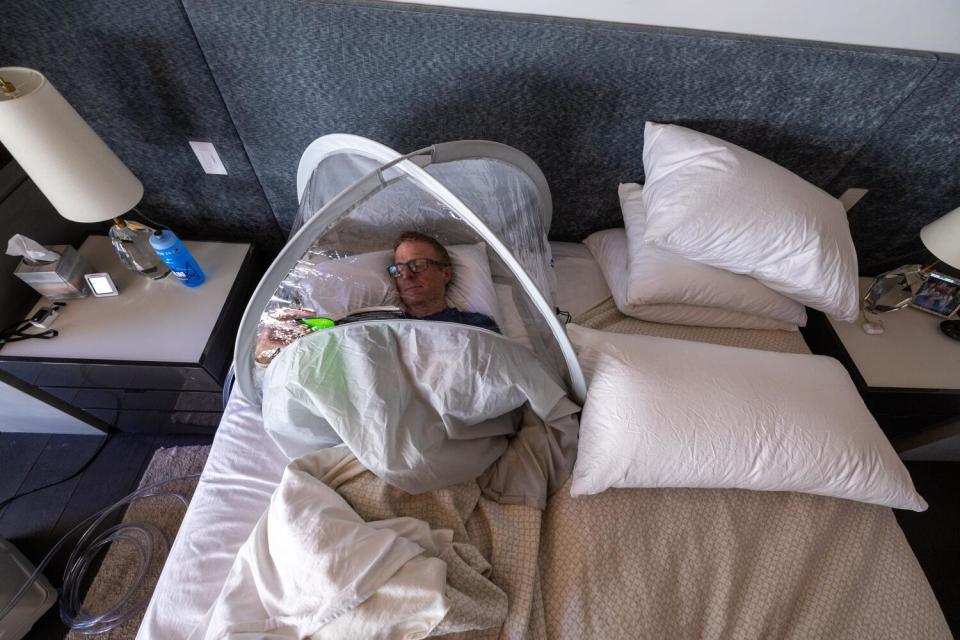Made it! California climbers use pioneering techniques to summit Mt. Everest
Sleeping with your head in a bag works.
Graham Cooper and Adrian Ballinger, California mountaineers whose acclimatization for Mt. Everest included sleeping at home with their heads in hypoxic tents meant to mimic the agonies of extreme altitude, reached the world’s highest summit on Wednesday.
The pioneering acclimatization technique helped cut the time of the expedition roughly in half, from about two months to less than one. They also ascended the much less traveled northern route, starting in Tibet instead of Nepal, to avoid the treacherous crowding and chaos on the more popular southern route.
A week ago on the southern route, a harrowing human traffic jam left dozens of climbers shuffling in single file along a narrow ridge just below the summit — a pileup that turned deadly when a snow cornice collapsed beneath their feet.
Six climbers plummeted toward a nearly vertical 11,000-foot rock wall below. Four survived because they were properly attached to a fixed rope. Two others, who apparently weren’t, slid helplessly into the abyss as the crowd looked on in horror.
The growing crowds, filth and danger on the southern route prompted Ballinger, founder of the Olympic Valley-based guide service Alpenglow Expeditions, to start taking his clients up the north side of the mountain instead.
“It’s colder, the route is more difficult, and the bureaucracy of dealing with China and getting the permits is a complete nightmare,” Ballinger told The Times in an interview before the trip. “But despite those things, the Chinese are attempting to regulate, so once you get on the mountain, it’s safer, it’s cleaner, and it’s much less busy.”
Ballinger, who has been climbing and guiding on Mt. Everest since 2009, stuck to his principles and put his Everest trips on hold after the Chinese government shut down its side of the mountain in 2020 in response to the COVID-19 pandemic.
The May expedition was his first time back since then.
On Wednesday, under perfectly blue skies with snow-capped peaks stretching to the horizon in every direction, he stood on the summit shouting over the wind: “It’s been unbelievable!”
Read more: California climbers train for Mt. Everest from the comfort of their own beds
In all, 23 climbers, guides and Sherpas on the Alpenglow team reached the summit on Tuesday and Wednesday.
But there were plenty of obstacles along the way.
First, the Chinese government made a last-minute change to their permits, forcing a tense dance with the bureaucracy and causing a week's delay in entering the country. The start date mattered, because there is only a short period each year, generally in late May, when the weather is good enough to attempt to climb to Everest's 29,032-foot summit. Expeditions have to be planned meticulously, and any delay can put the whole enterprise in peril.
The team also had to battle dangerous winds.
On Monday, as they broke into the "death zone" above 26,000 feet — where most human bodies begin to fatally break down without supplemental oxygen — Ballinger posted about the conditions on Instagram. With the wind howling and the bright white summit peeking over his right shoulder in the distance, he tugged down his oxygen mask and told the camera: "The wind's a little more reasonable now."
"It's a close one, though," he added, "on the edge of not having the [safety] margin I want."
In the end, the weather cooperated, ending a five-year wait for Ballinger to return to the highest point on Earth. It was his ninth time on the summit.
Read more: Why some of California's most outdoorsy people are moving to...Las Vegas?
For Cooper, 54, an Oakland biotech executive with an impressive endurance sports resume, it was the physical ordeal of a lifetime. And that's a lot coming from a man who has competed in the Ironman World Championship in Hawaii 11 times and won the legendary Western States Endurance Run, a 100-mile ultra-marathon in California's Sierra Nevada.
The four-day push to the summit was like running four consecutive Ironmans, Cooper said during a phone interview from Everest base camp on Friday morning.
He coughed throughout the call and his exhaustion was palpable as he described the worst part: a sudden case of acute renal failure during the descent.
"I peed a full bottle of what looked like Peet's Coffee," he said. Ballinger was attempting to arrange a helicopter rescue when, to everyone's relief, Cooper started "peeing clear again," he said.

Because of the permit snafu, which meant fewer days to acclimatize on the mountain itself, the trip would have been a failure without the weeks of acclimatizing by sleeping with their heads in those bags at home, Cooper said.
"I would have been absolutely crushed without that," Cooper said.
During the last night in the tent before attempting the summit, Cooper said he had serious doubts about whether they'd make it. They had climbed through 30-mph winds to reach that point, and the forecast called for more of the same the next day. If things got any worse, they would have to turn around.
But the weather held and, climbing from the north side, the Alpenglow team had the mountain gloriously to themselves.
"It definitely measured up" to expectations, Cooper said. "It was an epic adventure."
This story originally appeared in Los Angeles Times.

 Yahoo News
Yahoo News 
